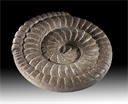Description
Having pioneered the coiled-serpent style, the Aztecs executed it in a wide range of sizes and proportions. This Coiled Rattlesnake exemplifies a flat type. At 2 feet across and about 7 inches high, it is an impressive piece; its overall form is satisfying and nicely crafted.
Top and bottom it is shaped to represent the living venomous reptile of the countryside with its typical arrow-shaped head poised to strike. Comprising a low coil of three or four levels, the serpent’s body winds counterclockwise from its flattened head, which is not extended. The head, with shallowly carved eyes and teeth, bears a cylindrical vertical hole on its top, possibly for incense, and a smaller cylindrical horizontal hole at the base of the nose, just above the bifid tongue. This tongue thrusts down from the closed mouth, past two levels of its coiled body, almost touching the set of 13 rattles that form the front quarter of the circumference of the base. This circumference measures about 6 feet, and thus the uncoiled serpent would be about 11 feet long, more than twice as long as most very large living rattlesnakes. This type of serpent sculpture is fairly well known, and other similar examples are found at The Field Museum in Chicago and in the Museo Nacional de Antropología in Mexico City.
The practice of carving the underside of a sculpture as carefully as the visible top part is characteristic of Aztec artisanship, suggesting that the indigenous attitude valued all relevant surfaces of certain sacred images whether perceptible to a human observer or not. Ancient peoples of Mesoamerica perceived a vibrant and interactive world around them, and their intent in producing sculptures had only partially to do with impressing the humans who saw them. To the Aztecs and others, sentience was not an exclusively human trait but also characterized the spiritually charged earth. This sculpture is a telling example of the contrast between modern concepts of art and the traditional world’s production of aesthetically masterful pieces whose complicated significance challenges the outsider’s understanding.
PC.B.070 bears 13 rattles, as do the examples from The Field Museum and the Museo Nacional. Although other serpent sculptures have different numbers of rattles, a count of 13 is an important symbolic and divinatory element in Aztec iconography. The Aztec divinatory almanac links day names to numbers in groups of 13; in Aztec cosmology, the upper world has 13 levels.
Although many pieces of major Aztec sculpture express the fantastic and hybrid features of the culture’s complex iconographic program, the Bliss Collection’s Coiled Rattlesnake is a good example of the strong strain of naturalism that characterized some of the most beautiful pieces.
Bibliography
Benson, Elizabeth P. 1963 Handbook of the Robert Woods Bliss Collection of Pre-Columbian Art. Dumbarton Oaks, Trustees for Harvard University, Washington, D.C., p. 23, cat. 105.
Bliss, Robert Woods 1947 Indigenous Art of the Americas: Collection of Robert Woods Bliss. National Gallery of Art, Smithsonian Institution, Washington, D.C., p. 23, 112-113, cat. 109.
Bliss, Robert Woods 1957 Pre-Columbian Art: The Robert Woods Bliss Collection. Text and Critical Analyses by S. K. Lothrop, Joy Mahler and William F. Foshag. Phaidon, New York. p. 242, cat. 54, pl. XL, XLI.
Bliss, Robert Woods 1959 Pre-Columbian Art: The Robert Woods Bliss Collection. 2nd ed. Text and Critical Analyses by S. K. Lothrop, Joy Mahler and William F. Foshag. Phaidon, London. p. 250, cat. 54, pl. XL, XLI.
Boone, Elizabeth Hill 1982 Towards a More Precise Definition of the Aztec Painting Style. In Pre-Columbian Art History: Selected Readings, Alana Cordy-Collins, ed., pp. 153-168. Peek Publications, Palo Alto, Calif., p. 158, fig. 11.
Dockstader, Frederick J. 1961 Before and after Columbus - Sculpture. Art in America 49 (3). p. 37.
Graves, Robert 1977 [1968] Introduction. In New Larousse Encyclopedia of Mythology, Félix Guirand, ed., pp. xi, 500. New ed. Hamlyn, London; New York. p. 433.
Guirand, Félix 1968 New Larousse Encyclopedia of Mythology. New ed. Hamlyn, London; New York. p. 433.
Gutiérrez Solana, Nelly 1987 Las Serpientes En El Arte Mexica. 1st ed. Colección De Arte; 40. Universidad Nacional Autónoma de México Coordinación de Humanidades, México. p. 97, pl. 49.
Ishida, Eiichir? 1962 Amerika. Sekai Bijutsu Zensh? ; 24. Kadokawa Shoten, Tokyo. p. 208, fig. 135.
Kubler, George 1984 Ancient American Gods and Their Living Impersonators. Apollo CXIX (266). p. 15-16, fig. 9.
Lippincott, Kristen 1999 The Story of Time. Merrell Holberton, London. p. 67, cat. 057.
Pasztory, Esther 1998 Pre-Columbian Art. Cambridge University Press, Cambridge, UK; New York, NY. p. 94-95, fig. 67-68.
Smith, Michael Ernest 1996 The Aztecs. Peoples of America. Blackwell Publishers, Oxford, UK ; Cambridge, Mass., p. 266, fig. 10.8.
Smith, Michael Ernest 2003 The Aztecs. 2nd ed. The Peoples of America. Blackwell Publishers, Malden, MA. p. 257, 259, fig. 11.8.
Staff writer 2003 From the Collection: Washington's Prize Possessions. In The Washington Post, pp. G9, Washington, DC.
Acquisition History
Purchased from Earl Stendahl, Los Angeles (dealer), by Robert Woods Bliss, March 29, 1946.
Robert Woods Bliss Collection of Pre-Columbian Art, Washington, DC, ca. 1946-1962.
Dumbarton Oaks Research Library and Collection, Pre-Columbian Collection, Washington, DC.


